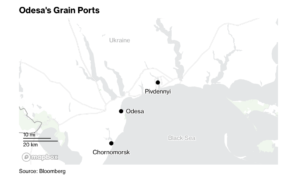The USDA is projecting that the ag trade deficit will shrink in FY2026 even more than previously anticipated. USDA expects the trade deficit to fall from $43.7 billion in FY2025…
Twelve Additional Ships To Enter Black Sea “Humanitarian Corridor”
Reuters writers Olena Harmash and Pavel Polityuk reported today that, “Ukraine’s navy said on Wednesday that 12 more cargo vessels were ready to enter a fledgling Black Sea shipping corridor on their way to Ukrainian ports, as Kyiv steps up a push to defy a de facto Russian blockade on its vital sea exports.
“Russia, which has a much more powerful and bigger naval fleet in the Black Sea, pulled out of a deal in July that had allowed wartime Ukraine to safely ship food products out through what is traditionally its main export corridor.
“Ukraine responded by setting up a temporary ‘humanitarian corridor’ for cargo vessels, and several ships have departed from Ukraine’s Black Sea ports since.”

The Reuters article pointed out that,
‘In total to enter the new corridor we have 12, and 10 to leave. That is as of now,’ Navy spokesperson Dmytro Pletenchuk told an online media briefing on Wednesday.
“Those figures appeared to indicate an increase in the amount of shipping traffic set to use the corridor, although Pletenchuk did not say when the vessels were expected to sail.”
Nonetheless, Harmash and Polityuk explained that, “However, Ukrainian grain exports have declined by 24% so far in the 2023/24 July-June season as the country’s major export routes were blocked.”
Today’s article added that, “Ukraine maritime exports totalled 2.4 million tons in September and 99% of the volume were covered by Danube ports, brokers said.”
Yesterday, New York Times writer Matthew Mpoke Bigg reported that, “The government in Kyiv has been working to establish a new shipping corridor from its sea ports.
“Under the new route, ships hug the coast before entering the waters of Romania and then Bulgaria — both members of NATO. At least six cargo vessels have used the temporary corridor in recent weeks, apparently without incident.
“Amid the strikes on Odesa, Ukrainian farmers have stepped up their use of the country’s smaller Danube River ports for export, though those also have been targeted by Russian attacks. At the same time, overland export routes have been fraught with delays and opposition from Poland, as well as some of Ukraine’s other European Union neighbors, who say an influx of cheap Ukrainian grain hit prices for domestic produce.”
And in a related opinion item today, The Bloomberg editorial board indicated that, “Russia’s blockade of Black Sea shipping routes and its bombing campaigns against ports on the Danube River have forced Ukraine to use slower and more expensive land routes to get vital exports to markets. The EU had waived quotas and tariffs on Ukraine’s foodstuffs after Russia’s invasion, but a flood of imports into eastern member states created an uproar from local farmers. In May, under pressure from several states, the EU relented and imposed a temporary ban on sales of Ukrainian grains in Bulgaria, Hungary, Poland, Romania and Slovakia. Meanwhile, Russia’s own hefty harvest helped drive down wheat prices further.

“When the ban expired last month, the EU resisted calls to extend it, raising the prospect of another spike in imports. The timing was bad for Poland’s ruling Law & Justice Party, which relies heavily on rural votes and faces an Oct. 15 election. It pledged to defy the EU and keep the ban in place, which caused Ukrainian President Volodymyr Zelenskiy to file a complaint with the World Trade Organization and question whether Poland’s solidarity with Ukraine was mere ‘theater.’ Polish leaders, in turn, have warned Zelenskiy that his rhetoric could jeopardize future weapons shipments to Ukraine.”
Also today, Reuters writer Peter Hobson reported that, “Ukraine, a large wheat exporter, said on Tuesday it hopes to speed up exports of grain and other farm products by shifting some border checks from its busy frontier with Poland to the Lithuanian port of Klaipeda.”
Elsewhere, Reuters writer Pavel Polityuk reported yesterday that, “Ukraine’s agriculture ministry said on Tuesday that farmers had sown almost 3 million hectares of winter crops as of Oct. 3.
“The area included 1.7 million hectares of winter wheat, or 40% of the expected area, the ministry said in a statement.”
In other developments, Dow Jones writer Kirk Maltais reported yesterday that, “StoneX Group raised its estimates for corn and soybean yields ahead of next week’s WASDE report. The firm forecasts U.S. corn yield at 175.5 bushels an acre, which is up from 175 bushels an acre reported last month. Soybean yields are seen at 50.4 bushels an acre, up from 50.1 bushels an acre estimated last month by the USDA.”





